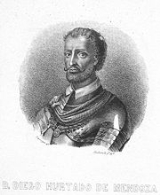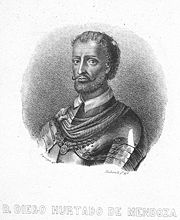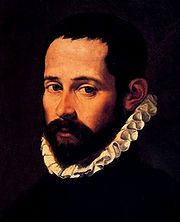
Diego Hurtado de Mendoza
Encyclopedia


Spain
Spain , officially the Kingdom of Spain languages]] under the European Charter for Regional or Minority Languages. In each of these, Spain's official name is as follows:;;;;;;), is a country and member state of the European Union located in southwestern Europe on the Iberian Peninsula...
novel
Novel
A novel is a book of long narrative in literary prose. The genre has historical roots both in the fields of the medieval and early modern romance and in the tradition of the novella. The latter supplied the present generic term in the late 18th century....
ist, poet
Poetry
Poetry is a form of literary art in which language is used for its aesthetic and evocative qualities in addition to, or in lieu of, its apparent meaning...
, diplomat and historian, a younger son of the count of Tendillas, governor of Granada
Granada
Granada is a city and the capital of the province of Granada, in the autonomous community of Andalusia, Spain. Granada is located at the foot of the Sierra Nevada mountains, at the confluence of three rivers, the Beiro, the Darro and the Genil. It sits at an elevation of 738 metres above sea...
, was born in that city in 1503. The marquis of Santillana was his great-grandfather.
On leaving the University of Salamanca
University of Salamanca
The University of Salamanca is a Spanish higher education institution, located in the town of Salamanca, west of Madrid. It was founded in 1134 and given the Royal charter of foundation by King Alfonso IX in 1218. It is the oldest founded university in Spain and the third oldest European...
, Mendoza abandoned his intention of taking orders, served under Charles V
Charles V, Holy Roman Emperor
Charles V was ruler of the Holy Roman Empire from 1519 and, as Charles I, of the Spanish Empire from 1516 until his voluntary retirement and abdication in favor of his younger brother Ferdinand I and his son Philip II in 1556.As...
in Italy, and attended lectures at the universities of Bologna, Padua and Rome. In 1537 he was sent to England to arrange a marriage between Henry VIII
Henry VIII of England
Henry VIII was King of England from 21 April 1509 until his death. He was Lord, and later King, of Ireland, as well as continuing the nominal claim by the English monarchs to the Kingdom of France...
and the duchess of Milan, as well as a marriage between Prince Louis of Portugal and Mary Tudor
Mary I of England
Mary I was queen regnant of England and Ireland from July 1553 until her death.She was the only surviving child born of the ill-fated marriage of Henry VIII and his first wife Catherine of Aragon. Her younger half-brother, Edward VI, succeeded Henry in 1547...
. Despite the failure of his mission, he retained the confidence of the emperor, and in 1539 was appointed ambassador at Venice
Venice
Venice is a city in northern Italy which is renowned for the beauty of its setting, its architecture and its artworks. It is the capital of the Veneto region...
. During his years in Venice he built up his library, buying books printed by the Aldine Press
Aldine Press
Aldine Press was the printing office started by Aldus Manutius in 1494 in Venice, from which were issued the celebrated Aldine editions of the classics . The Aldine Press is famous in the history of typography, among other things, for the introduction of italics...
and employing scribes to copy Greek manuscripts. He procured copies of the Greek manuscripts belonging to Cardinal Bessarion, and acquired other rare codices from the monastery of Mount Athos
Mount Athos
Mount Athos is a mountain and peninsula in Macedonia, Greece. A World Heritage Site, it is home to 20 Eastern Orthodox monasteries and forms a self-governed monastic state within the sovereignty of the Hellenic Republic. Spiritually, Mount Athos comes under the direct jurisdiction of the...
. The first printed Greek edition of the works of Josephus
Josephus
Titus Flavius Josephus , also called Joseph ben Matityahu , was a 1st-century Romano-Jewish historian and hagiographer of priestly and royal ancestry who recorded Jewish history, with special emphasis on the 1st century AD and the First Jewish–Roman War, which resulted in the Destruction of...
, based on texts from Mendoza's collection, was edited by the Flemish humanist Arnoldus Arlenius
Arnoldus Arlenius
Arnoldus Arlenius Peraxylus, , born Arndt or Arnout van Eyndhouts or van Eynthouts, also known as Arnoud de Lens, was a Dutch humanist philosopher and poet....
, who worked in Mendoza's library, and published in Basle by Hieronymus Froben
Hieronymus Froben
Hieronymus Froben was a famous pioneering printer in Basel and the eldest son of Johann Froben. He was educated at the University of Basel and traveled widely in Europe....
in 1544.
He acted for some time as military governor of Siena
Siena
Siena is a city in Tuscany, Italy. It is the capital of the province of Siena.The historic centre of Siena has been declared by UNESCO a World Heritage Site. It is one of the nation's most visited tourist attractions, with over 163,000 international arrivals in 2008...
, represented Spain diplomatically at the Council of Trent
Council of Trent
The Council of Trent was the 16th-century Ecumenical Council of the Roman Catholic Church. It is considered to be one of the Church's most important councils. It convened in Trent between December 13, 1545, and December 4, 1563 in twenty-five sessions for three periods...
, and in 1547 was nominated special plenipotentiary at Rome, where he remained till 1554. He was never a favourite of Philip II
Philip II of Spain
Philip II was King of Spain, Portugal, Naples, Sicily, and, while married to Mary I, King of England and Ireland. He was lord of the Seventeen Provinces from 1556 until 1581, holding various titles for the individual territories such as duke or count....
, and a quarrel with a courtier resulted in his banishment from court in June 1568. The remaining years of his life, which were spent at Granada, he devoted to the study of Arabic
Arabic language
Arabic is a name applied to the descendants of the Classical Arabic language of the 6th century AD, used most prominently in the Quran, the Islamic Holy Book...
(which he had learned at home when growing up), to poetry, and to his history of the Moorish insurrection of 1568–1570. He died in 1575, leaving his library to the king.
His Guerra de Granada (concerning the 1568 Morisco Revolt
Morisco Revolt
The Morisco Revolt , also known as War of Las Alpujarras or Revolt of Las Alpujarras, in what is now Andalusia in southern Spain, was a rebellion against the Crown of Castile by the remaining Muslim converts to Christianity from the Kingdom of Granada.-The defeat of Muslim Spain:In the wake of the...
in the
Alpujarras) was published in Madrid
Madrid
Madrid is the capital and largest city of Spain. The population of the city is roughly 3.3 million and the entire population of the Madrid metropolitan area is calculated to be 6.271 million. It is the third largest city in the European Union, after London and Berlin, and its metropolitan...
in 1610 and in Lisbon
Lisbon
Lisbon is the capital city and largest city of Portugal with a population of 545,245 within its administrative limits on a land area of . The urban area of Lisbon extends beyond the administrative city limits with a population of 3 million on an area of , making it the 9th most populous urban...
by Luis Tribaldos de Toledo in 1627; the delay was doubtless due to Mendoza's severe criticism of contemporaries who survived him. A complete edition was not published until 1730. In some passages the author deliberately imitates Sallust
Sallust
Gaius Sallustius Crispus, generally known simply as Sallust , a Roman historian, belonged to a well-known plebeian family, and was born at Amiternum in the country of the Sabines...
and Tacitus
Tacitus
Publius Cornelius Tacitus was a senator and a historian of the Roman Empire. The surviving portions of his two major works—the Annals and the Histories—examine the reigns of the Roman Emperors Tiberius, Claudius, Nero and those who reigned in the Year of the Four Emperors...
; his style is, on the whole, vivid and trenchant, his information is exact, and in critical insight he is not inferior to Juan de Mariana
Juan de Mariana
Juan de Mariana, also known as Father Mariana , was a Spanish Jesuit priest, Scholastic, historian, and member of the Monarchomachs....
.
The attribution to Mendoza of Lazarillo de Tormes
Lazarillo de Tormes
The Life of Lazarillo de Tormes and of His Fortunes and Adversities is a Spanish novella, published anonymously because of its heretical content...
is disputed, but documents recently discovered by the Spanish paleographer Mercedes Agulló reinforce the hypothesis. That he excelled in picaresque malice is proved by his indecorous verses written in the old Castilian metres and in the more elaborate measures imported from Italy. Mendoza is believed to be the author of the letters to Feliciano de Silva and to Captain Salazar, published by Antonio Paz y Melia in Sales Espanolas (Madrid, 1900).
Publications
- A. Senn y Alonso, D. Diego Hurtado de Mendoza, apuntes biográfico-críticos (Granada, 1886)
- Calendar of Letters and Papers foreign and domestic, Henry VIII., vols. xii. and xiii.
- C. Graux, Essai sur l'origine du fonds grec de l'Escurial (Paris, 1880)
- R. Foulch-Delbosc, Étude sur la Guerra de Granada in the "Revue hispanique" (Paris, 1894), vol. i.
- A. Morel-FatioAlfred Morel-FatioAlfred Paul Victor Morel-Fatio was the leading French Hispanist of his time, educated at École des chartes, Paris....
, "Quelques remarques sur La Guerre de Grenade de D. Diego Hurtado de Mendoza," in Annuaire de l'Ecole des Hautes Etudes, 1914-15 (Paris, 1914).

